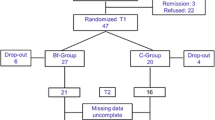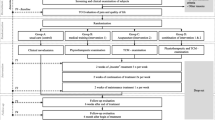Abstract
Therapeutic mechanisms hypothesized to underlie improvements in tension headache activity achieved with combined relaxation and eleclromyographic (EMG) biofeedback therapy were examined. These therapeutic mechanisms included (1) changes in EMG activity in frontal and trapezii muscles, (2) changes in central pain modulation as indexed by the duration of the second exteroceptive silent period (ES2), and (3) changes in headache locus of control and self-efficacy. Forty-four young adults with chronic tension-type headaches were assigned either to six sessions of relaxation and EMG biofeedback training (N = 30) or to an assessment only control group (N = 14) that required three assessment sessions. Measures of self-efficacy and locus of control were collected at pre- and posttreatment, and ES2 was evaluated at the beginning and end of the first, third, and lost session. EMG was monitored before, during, and following training trials. Relaxation/EMG biofeedback training effectively reduced headache activity: 51.7% of subjects who received relaxation/biofeedback therapy recorded at least a 50% reduction in headache activity following treatment, while controls failed to improve on any measure. Improvements in headache activity in treated subjects were correlated with increases in self-efficacy induced by biofeedback training but not with changes in EMG activity or in ES2 durations. These results provide additional support for the hypothesis that cognitive changes underlie the effectiveness of relaxation and biofeedback therapies, at least in young adult tension-type headache sufferers.
Similar content being viewed by others
REFERENCES
Andrasik, F. (1979). A test of the specific effects in the biofeedback treatment of tension headache. Unpublished doctoral dissertation, Ohio University, Athens.
Andrasik, F., & Holroyd, K. A. (1980). A test of specific and nonspecific effects in the biofeedback treatment for tension headache. Journal of Consulting and Clinical Psychology, 48, 575–586.
Andrasik, F., Holroyd, K. A., & Abell, T. (1979). Prevalence of headache within a college student population: A preliminary analysis. Headache, 19, 384–387.
Arena, J. G., Bruno, G. M., Hannah, S. L., & Meador, K. J. (1995). A comparison of frontal electromyographic biofeedback training, trapezius electromyographic biofeedback training, and progressive muscle relaxation therapy in the treatment of tension headache. Headache, 35, 411–419.
Basmajian, J. V. (1989). Biofeedback: Principles and practice for clinicians (3rd edition). Baltimore: Williams & Wilkins.
Bendtsen, L., Jensen, R., Brennum, J., Arendt-Nielsen, L., & Olesen, J. (1996). Exteroceptive suppression of temporal muscle activity is normal in patients with chronic tension-type headache and not related to actual headache state. Cephalalgia, 16, 251–256.
Bendtsen, L., Jensen, R., & Olesen, J. (1996). Qualitatively altered nociception in chronic myofacial pain. Pain, 65, 259–264.
Blanchard, E. B., & Andrasik, F. (1985). Management of chronic headaches: A psychological approach. New York: Pergamon Press.
Blanchard, E. B., Andrasik, F., Ahles, T. A., Teders, S. J., & O'Keefe, D. (1980). Migraine and tension headache: A meta-analytic review. Behavior Therapy, 11, 613–631.
Blanchard, E. B., Kim, M., Hermann, C. U., & Steffek, B. D. (1993). Preliminary results of the effects on headache relief of perception of success among tension headache patients receiving relaxation. Headache Quarterly, Current Treatment and Research, 4, 249–253.
Bogaards, M. C., & ter Kuile, M. M. (1994). Treatment of recurrent tension headache: A meta-analytic review. The Clinical Journal of Pain, 10, 174–190.
Budzynski, T. H., Stoyva, J. M., & Adler, C. S. (1970). Feedback-induced muscle relaxation: Application to tension headache. Journal of Behavior Therapy and Experimental Psychiatry, 1, 205–211.
Budzynski, T. H., Sioyva, J. M., Adler, C. S., & Mullaney, D. J. (1973). EMG biofeedback and tension headache: A controlled outcome study. Psychosomatic Medicine, 35, 484–496.
Cox, D. J., Freundlich, A., & Meyer, R. G. (1975). Differential effectiveness of electromyographic feedback, verbal instructions, and medication placebo with tension headaches. Journal of Consulting and Clinical Psychology, 43, 892.
Dostrovsky, J. O., Hu, J. W., Sessle, B. J., & Sumino, R. (1982). Stimulation sites in periaqueductal gray, nucleus raphe magnus and adjacent regions effective in suppressing oral-facial reflexes. Brain Research, 252, 287–297.
Epstein, L. H., & Abel, G. G. (1977). An analysis of biofeedback training effects for tension headache patients. Behavior Therapy, 8, 37–47.
Gobel, H., & Weigle, L. (1991). Exteroceptive suppression periods of temporal muscle activity and their value in differential diagnosis of headache disorders. Cephalalgia, 11, 65–66.
Hart, J. D., & Cichanski, K. A. (1981). A comparison of frontal EMG biofeedback and neck EMG biofeedback in the treatment of muscle-contraction headache. Biofeedback and Self-Regulation, 6, 63–74.
Haynes, S. N., Griffin, P., Mooney, D., & Parise, M. (1975). Electromyographic biofeedback and relaxation instructions in the treatment of muscle contraction headaches. Behavior Therapy, 6, 672–678.
Headache Classification Committee of the International Headache Society (1988). Classification and diagnostic criteria for headache disorders, cranial neuralgias, and facial pain. Cephalalgia, 8(Suppl 7), 1–96.
Holm, J. E. (1983). Headache vs. headache-free subjects: An evaluation of stressful events, cognitive appraisal, and coping strategies. Unpublished master's thesis, Ohio University, Athens.
Holroyd, K. A. (1979). Stress, coping, and the treatment of stress-related illness. In J. R. McNamara (Ed.), Behavioral approaches in medicine: Applications and analysis (pp. 191–226). New York: Plenum.
Holroyd, K. A., Andrasik, F., & Noble, J. (1980). A comparison of EMG biofeedback and a credible pseudotherapy in treating tension headache. Journal of Behavioral Medicine, 3, 29–39.
Holroyd, K. A., & Penzien, D. B. (1983). EMG biofeedback and tension headache: Therapeutic mechanisms. In K. A. Holroyd, B. Schlote, & H. Zenz (Eds.), Perspectives in research on headache (pp. 147–162). New York: C. J. Hagrefe.
Holroyd, K. A., & Penzien, D. B. (1986). Client variables and the behavioral treatment of recurrent tension headache: A meta-analytic review. Journal of Behavioral Medicine, 9, 515–536.
Holroyd, K. A., Penzien, D. B., Hursey, K. G., Tobin, D. L., Rogers, L., Holm, J. E., Marcille, P. J., Hall, J. R., & Chila, A. G. (1984). Change mechanisms in EMG biofeedback training: Cognitive changes underlying improvements in tension headache. Journal of Consulting and Clinical Psychology, 52, 1039–1053.
Hugdahl, K., & Ost, L. (1981). On the difference between statistical and clinical significance. Behavioral Assessment, 3, 289–295.
Kroener-Herwig, B., & Weich, K. (1989). Biofeedback in chronic headache: Is physiological learning necessary for positive outcome? Cephalalgia, 9(Suppl 10), 383–384.
Lacroix, J. M., Clarke, M. A., Bock, J. C., & Doxey, N. C. (1986). Physiological changes after biofeedback and relaxation training for multiple-pain tension-headache patients. Perceptual and Motor Skills, 63, 139–153.
Lass, A. H., & Tasman, N. L. (1969). “The secret sharer” and other great stories. New York: The New American Library.
Linet, M. S., Stewart, W. F., Celentano, D. D., Ziegler, D., & Sprecher, M. (1989). An epidemiologic study of headache among adolescents and young adults. Journal of the American Medical Association, 261, 2211–2216.
Lipchik, G. L., Holroyd, K. A., France, C. R., Kvaal, S. A., Segal, D., Cordingley, G. E., Rokicki, L. A., & McCool, H. R. (1996). Central and peripheral mechanisms in chronic tension-type headache. Pain, 64, 467–475.
Lipchik, G. L., Holroyd, K. A., Talbot, F., & Greer, M. (in press). Pericranial muscle tenderness and exteroceptive suppression of temporalis muscle activity: A blind study of chronic tension-type headache. Headache.
Martin, N. J., Holroyd, K. A., & Penzien, D. B. (1990). The headache-specific locus of control: Adaptation to recurrent headaches. Headache, 30, 729–734.
Martin, N. J., Holroyd, K. A., & Rokicki, L. A. (1993). The headache self-efficacy scale: Adaptation to recurrent headaches. Headache, 33, 244–248.
Mathew, N. T., Leis, A. A., Ali, S., & Dimitrijevic, M. (1992, June). Evidence for dysfunction of pontobulbar inhibitory interneurones in patients with chronic headache. Presented at the American Association for the Study of Headache Conference, Toronto, Canada.
Mense, S. (1993). Nociception from skeletal muscle in relation to clinical muscle pain. Pain, 54, 241–289.
Nakashima, K., & Takahashi, K. (1991). Exteroceptive suppression of the masseter, temporalis and, trapezius muscles produced by mental nerve stimulation in patients with chronic headaches. Cephalalgia, 11, 23–28.
Nakashima, K., Takahashi, K., Azumi, T., & Ishida, G. (1990). Exteroceptive suppression of the masseter and temporalis muscles produced by electrical stimulation of the mental nerve in patients with Parkinson's disease. Acta Neurologica Scandinavica, 81, 407–410.
Paulus, W., Raubuchi, O., Straube, A., & Schoenen, J. (1992). Exteroceptive suppression of temporalis muscle activity in various types of headache. Headache, 32, 41–44.
Rasmussen, B. K., Jensen, R., & Olesen, J. (1991). A population-based analysis of the diagnostic criteria of the International Headache Society. Cephalalgia, 11, 129–134.
Schoenen, J. (1989). Exteroceptive silent periods of temporalis muscle in headache. In D. van Steenberghe & A. De Laat (Eds.), EMG jaw reflexes in man (pp. 357–368). Leuven University Press.
Schoenen, J. (1993a). Exteroceptive suppression of temporalis muscle activity: Methodological and physiological aspects. Cephalalgia, 13, 3–10.
Schoenen, J. (1993b). Exteroceptive suppression of temporalis muscle activity in patients with chronic headache and normal volunteers: Methodology, clinical and pathophysiological relevance. Headache, 33, 3–17.
Schoenen, J., Jarnart, B., Gerard, P., Lenarduzzi, P., & Delwaide, P. J. (1987). Exteroceptive suppression of temporalis muscle activity in chronic headache. Neurology, 37, 1834–1836.
Sessle, B. J., & Hu, J. W. (1981). Rophe-induced suppression of the jaw-opening reflex and single neurons in trigeminal subnucleus oralis, and influence of naloxone and subnucleus caudalis. Pain, 10, 19–36.
Thompson, J. K., Raczynski, J. M., Haber, J. D., & Sturgis, E. T. (1983). The control issue in biofeedback training. Biofeedback and Self-Regulation, 3, 153–164.
Wallasch, T. M., Reinecke, M., & Langhor, H. D. (1991). EMG analysis of the late exteroceptive suppression period of temporal muscle activity in episodic and chronic tension-type headaches. Cephalalgic, 11, 109–112.
Whatmore, G. B., Whatmore, N. J., & Fisher, L. D. (1981). Is frontalis activity a reliable indicator of the activity in other skeletzl muscles? Biofeedback and Self-Regulation, 6, 305–314.
Author information
Authors and Affiliations
Rights and permissions
About this article
Cite this article
Rokicki, L.A., Holroyd, K.A., France, C.R. et al. Change Mechanisms Associated with Combined Relaxation/EMG Biofeedback Training for Chronic Tension Headache. Appl Psychophysiol Biofeedback 22, 21–41 (1997). https://doi.org/10.1023/A:1026285608842
Issue Date:
DOI: https://doi.org/10.1023/A:1026285608842




